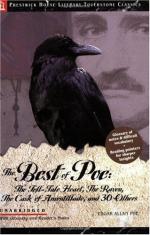Poe, like Hawthorne, came in with the decline of the Romantic school, and none delighted more than he to laugh at its calamity. Yet his heart was with the romancers and their Oriental or Gothic effects. His invention, so rich in the prose tales, seemed to desert him when he wrote verse; and his judgment told him that long romantic poems depend more upon incident than inspiration,—and that, to utter the poetry of romance, lyrics would suffice. Hence his theory, clearly fitted to his own limitations, that “a ‘long poem’ is a flat contradiction in terms.” The components of The Raven are few and simple: a man, a bird, and the phantasmal memory at a woman. But the piece affords a fine display of romantic material. What have we? The midnight; the shadowy chamber with its tomes of forgotten lore; the student,—a modern Hieronymus; the raven’s tap on the casement; the wintry night and dying fire; the silken wind-swept hangings; the dreams and vague mistrust of the echoing darkness; the black, uncanny bird upon the pallid bust; the accessories of violet velvet and the gloating lamp. All this stage effect of situation, light, color, sound, is purely romantic, and even melodramatic, but of a poetic quality that melodrama rarely exhibits, and thoroughly reflective of the poet’s “eternal passion, eternal pain.”
The rhythmical structure of The Raven was sure to make an impression. Rhyme, alliteration, the burden, the stanzaic form, were devised with singular adroitness. Doubtless the poet was struck with the aptness of Miss Barrett’s musical trochaics, in “eights,” and especially by the arrangement adopted near the close of “Lady Geraldine”:
“‘Eyes,’
he said, ’now throbbing through me! Are
ye eyes that did undo me?
Shining eyes, like antique
jewels set in Parian statue-stone!
Underneath that calm white
forehead, are ye ever burning torrid
O’er the desolate sand-desert
of my heart and life undone?’”
His artistic introduction of a third rhyme in both the second and fourth lines, and the addition of a fifth line and a final refrain, made the stanza of The Raven. The persistent alliteration seems to come without effort, and often the rhymes within lines are seductive; while the refrain or burden dominates the whole work. Here also he had profited by Miss Barrett’s study of ballads and romaunts in her own and other tongues. A “refrain” is the lure wherewith a poet or a musician holds the wandering ear,—the recurrent longing of Nature for the initial strain. I have always admired the beautiful refrains of the English songstress,—“The Nightingales, the Nightingales,” “Margret, Margret,” “My Heart and I,” “Toll slowly,” “The River floweth on,” “Pan, Pan is dead,” etc. She also employed what I term the Repetend, in the use of which Poe has excelled all poets since Coleridge thus revived it:
“O happy living things!
no tongue
Their beauty might declare:
A spring of love gushed from
my heart,
And I blessed them unaware:
Sure my kind saint took pity
on me,
And I blessed them unaware.”




